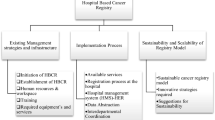Abstract
Purpose
Cancer survivors frequently receive care from a large number of physicians, creating challenges for coordination. We sought to explore whether cancer survivors whose providers have more patients in common (e.g., shared patients) tend to have higher quality and lower cost care.
Methods
We performed a retrospective cohort study of 8,661 patients diagnosed with loco-regional breast, prostate, or colorectal cancer. We examined survivorship care from days 366 to 1,095 following their cancer diagnosis. Our primary independent variable was “care density,” a novel metric of the extent to which a patient’s providers share patients with one another. Our outcome measures were health care utilization, quality metrics, and costs.
Results
In adjusted analyses, we found that patients with high care density—indicating high levels of patient-sharing among their providers—had significantly lower rates of hospitalization (OR 0.87, 95 % CI 0.75–1.00) and higher odds of an eye examination for diabetes (OR 1.31, 95 % CI 1.03–1.66) compared to patients with low care density. High care density was not associated with emergency department visits, avoidable outcomes, lipid profile following an angina diagnosis, or odds of glycosylated hemoglobin testing for diabetes. Patients with high care density had significantly lower total costs of care over 24 months (beta coefficient −$2,116, 95 % CI −$3,107 to −$1,125) along with lower inpatient and outpatient costs.
Conclusion
Cancer survivors treated by physicians who share more patients with one another tend to have some higher aspects of quality and lower cost care.
Implications of cancer survivors
If validated, care density may be a useful indicator for monitoring care coordination among cancer survivors and potentially targeting interventions that seek to improve care delivery.



Similar content being viewed by others
References
Institute of Medicine. From cancer patient to cancer survivor: lost in translation. Washington, DC: National Academy Press; 2006.
Pham HH, Schrag D, O’Malley AS, Wu B, Bach PB. Care patterns in Medicare and their implications for pay for performance. N Engl J Med. 2007;356(11):1130–9.
Pollack LA, Adamache W, Ryerson AB, Eheman CR, Richardson LC. Care of long-term cancer survivors. Cancer. 2009;115(22):5284–95.
Snyder CF, Earle CC, Herbert RJ, Neville BA, Blackford AL, Frick KD. Preventive care for colorectal cancer survivors: a 5-year longitudinal study. J Clin Oncol. 2008;26:1073–9.
Snyder CF, Frick KD, Peairs KS, et al. Comparing care for breast cancer survivors to non-cancer controls: a five-year longitudinal study. J Gen Intern Med. 2009;24:469–74.
Snyder CF, Frick KD, Herbert RJ, et al. Preventive care in prostate cancer patients: following diagnosis and for five-year survivors. J Cancer Surviv. 2011;5(3):283–91. doi:10.1007/s11764-011-0181-y.
McDonald K, Sundaram V, Bravata D, et al. Closing the quality gap: a critical analysis of quality improvement strategies. Volume 7—care coordination. Rockville, MD: AHRQ; 2007.
Bodenheimer T. Coordinating care—a perilous journey through the health care system. N Engl J Med. 2008;358:1064–71.
National Priorities Partnership. National priorities and goals: aligning our efforts to transform America’s healthcare. Washington, DC: National Quality Forum; 2008.
Rittenhouse DR, Shortell SM, Fisher E. Primary care and accountable care—two essential elements of delivery-system reform. N Engl J Med. 2009;361:2301–3.
Miller HD. From volume to value: better ways to pay for health care. Health Aff. 2009;28:1418–28.
Fisher ES, McClellan MB, Bertko J, et al. Fostering accountable health care: moving forward in Medicare. Health Aff. 2009;28(2):w219–31.
Rosenthal MB. Beyond pay for performance—emerging models of provider–payment reform. N Engl J Med. 2008;359:1197–200.
Siegel R, Naishadham D, Jemal A. Cancer statistics, 2013. CA Cancer J Clin. 2013;63(1):11–30.
American Cancer Society. Cancer facts & figures 2013. Atlanta, GA: American Cancer Society; 2013.
Rowland JH, Mariotto A, Alfano CM. Cancer survivors—United States, 2007. MMWR. 2011;60:269–72.
Earle CC, Burstein JJ, Winer EP, Weeks JC. Quality of non-breast cancer health maintenance among elderly breast cancer survivors. J Clin Oncol. 2003;21:1447–51.
Earle CC, Neville BA. Under use of necessary care among cancer survivors. Cancer. 2004;101:1712–9.
Snyder CF, Earle CC, Herbert RJ, Neville BA, Blackford AL, Frick KD. Trends in follow-up and preventive care for colorectal cancer survivors. J Gen Intern Med. 2008;23:254–9.
Snyder CF, Frick KD, Kantsiper ME, et al. Prevention, screening, and surveillance care for breast cancer survivors compared with controls: changes from 1998 to 2002. J Clin Oncol. 2009;27:1054–61.
Barnett ML, Landon BE, O’Malley AJ, Keating NL, Christakis NA. Mapping physician networks with self-reported and administrative data. Health Serv Res. 2011;46:1592–609.
Pollack CE, Weissman GE, Lemke KW, Hussey PS, Weiner JP. Patient sharing among physicians and costs of care: a network analytic approach to care coordination using claims data. J Gen Intern Med. 2013;28:459–65.
Bynum JP, Ross JS. A measure of care coordination? J Gen Intern Med. 2013;28(3):336–8.
Snyder CF, Frick KD, Herbert RJ, et al. Quality of care for comorbid conditions during the transition to survivorship: differences between cancer survivors and noncancer controls. J Clin Oncol. 2013;31(9):1140–8.
Asch SM, Sloss EM, Hogan C, Brook RJ, Kravitz RL. Measuring underuse of necessary care among elderly Medicare beneficiaries using inpatient and outpatient claims. JAMA. 2000;284:2325–33.
Charlson ME, Pompei P, Alex KL, Mackenzie CR. A new method of classifying prognostic comorbidity in longitudinal studies: development and validation. J Chron Dis. 1987;40:373–83.
Deyo RA, Cherkin DC, Ciol MA. Adapting a clinical comorbidity index for use with ICD-9-CM administrative databases. J Clin Epidemiol. 1992;45:613–9.
Klabunde CN, Potosky AL, Legler JM, Warren JL. Development of a comorbidity index using physician claims data. J Clin Epidemiol. 2000;53:1258–67.
Starfield B, Shi L, Macinko J. Contribution of primary care to health systems and health. Milbank Q. 2005;83:457–502.
Acknowledgments
We would like to thank Eric Roberts and Klaus Lemke. This was supported by the National Cancer Institute (R01CA149616 and K07 CA151910).
Conflict of interest
None.
Author information
Authors and Affiliations
Corresponding author
Appendix
Appendix
Rights and permissions
About this article
Cite this article
Pollack, C.E., Frick, K.D., Herbert, R.J. et al. It’s who you know: patient-sharing, quality, and costs of cancer survivorship care. J Cancer Surviv 8, 156–166 (2014). https://doi.org/10.1007/s11764-014-0349-3
Received:
Accepted:
Published:
Issue Date:
DOI: https://doi.org/10.1007/s11764-014-0349-3




